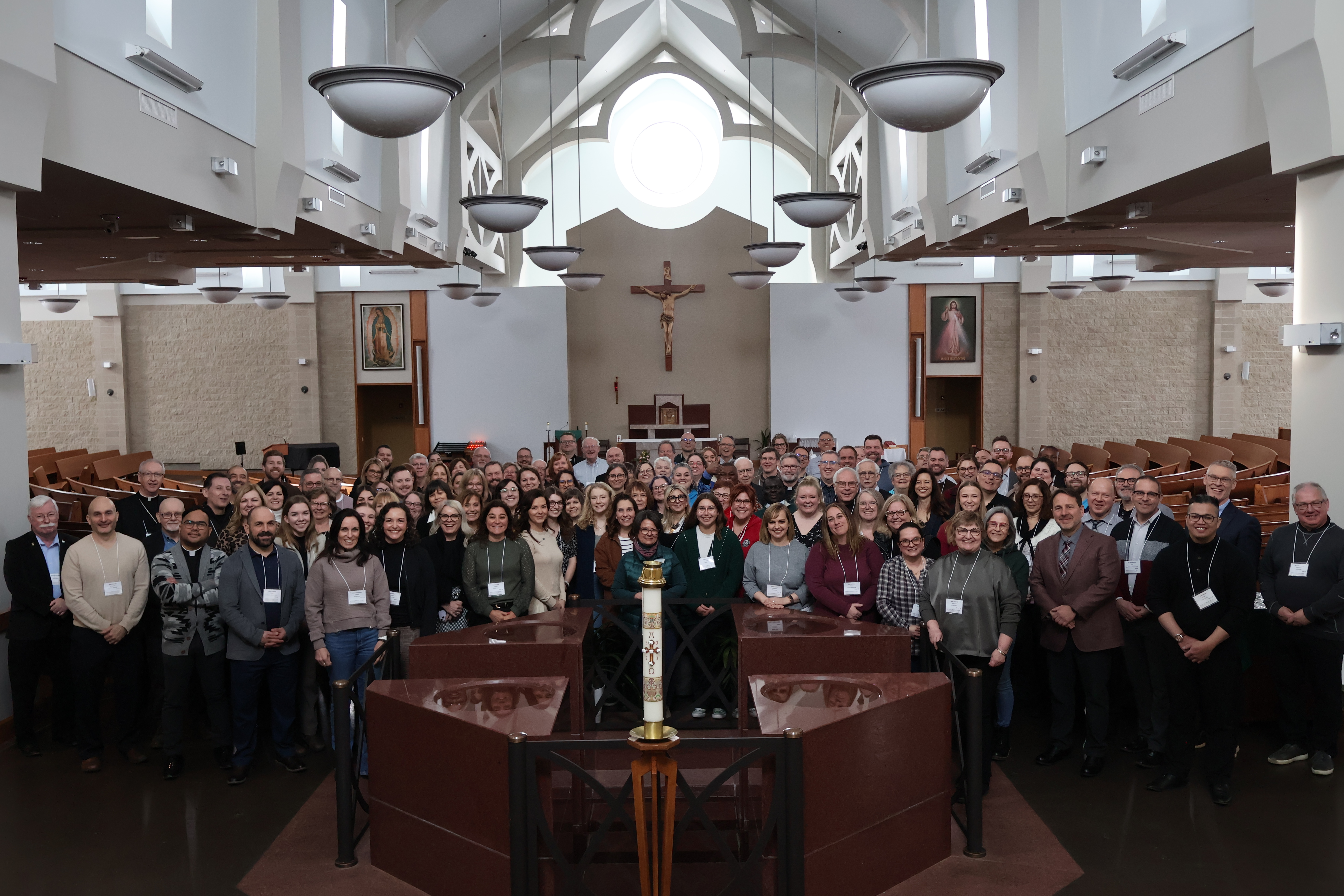This article was originally published in the Fall 2015 issue of The Catholic Dimension, and is re-posted here for public reference.
It is generally understood that publically-funded separate Catholic education is constitutionally guaranteed in the Province of Alberta. What is less well understood is the qualitative nature of that protection. Critics of separate Catholic education may be heard to express the opinion that although Catholic education is guaranteed constitutionally, there is no need to put flesh on those bones; that is, there is no need to support it fully and substantively in terms of full and equitable funding, school buildings, maintenance and control over policy, procedure and governance, the right to preferential hiring, promotion and discipline for denominational cause, and the right for Catholic theology, philosophy and doctrine to be fully permeated in all aspects of Catholic schools. The intent of this article is to explore the doctrines of hollow rights and permeation, as some of the constitutional underpinning of the qualitative protection of separate Catholic education in Alberta.
The Constitutional Guarantee
As indicated above, most persons understand the constitutional guarantee of publically-funded separate Catholic education in the province of Alberta.
The Constitution Act, 1867 was negotiated by the fathers of confederation at the Charlottetown Conference of 1864, the Quebec Conference of 1866, and the London Conference of 1867. It is universally understood that Confederation could not have been achieved without protection for denominational education in the new Canada, protection for the rights of Protestant education in the province of Quebec and Catholic education in the Province of Ontario.
The result was an historical compromise. Powers allocated to the federal government were set out in section 91 of the Constitution Act, 1867, and to the provinces in section 92. However, because protection for denominational education was so critical to being able to reach a constitutional compromise, it was set out in a separate section, section 93 of the Act:
“93. In and for each Province the Legislature may exclusively make Laws in relation to Education, subject and according to the following provisions:
(1) Nothing in any such Law shall prejudicially affect any Right or Privilege with respect to Denominational Schools which any Class of Persons have by Law in the Province at the Union;”.
The most often quoted excerpt to this effect is the speech in the House of Commons of Prime Minister Sir Charles Tupper in 1896 when he said:
“… but for assent that in the Confederation Act should be embodied a clause which would protect the rights of minorities, whether Catholic or Protestant, in this country, there would have been no confederation …”.
The issue of denominational education was also central to the entry of Alberta and Saskatchewan into confederation in 1905, and the subject of intense debate and negotiation. Section 17 of the Alberta Act, 1905 and the Saskatchewan Act, 1905 are identical:
“17. (1) Section 93 of The British North America Act, 1867, shall apply to the said province, with the substitution for paragraph (1) of the said section 93, of the following paragraph:--
1. ‘Nothing in any such law shall prejudicially affect any right or privilege with respect to separate schools which any class of persons have at the date of the passing of this Act, under the terms of chapters 29 and 30 of the Ordinances of the North-West Territories, passed in the year 1901, or with respect to religious instruction in any public or separate school as provided for in the said ordinances.’
2. In the appropriation by the Legislature or distribution by the Government of the province of any moneys for the support of schools organized and carried on in accordance with the said chapter 29 or any Act passed in amendment thereof, or in substitution therefor, there shall be no discrimination against schools of any class described in the said chapter 29.”
Eleven versions of that section were debated, amended and re-amended in months of debate. The primary actors in the Autonomy Debates and what has been called the North-West Schools Question where Prime Minister Sir Wilfred Laurier, Justice Minister Sir Charles Fitzpatrick and Minister of the Interior, Sir Clifford Sifton, all of whom considered those provisions to be a compromise for the purpose of allowing Alberta and Saskatchewan to come into Confederation. Sir Clifford Sifton is reported to have characterized any failure to reach such a compromise as potentially leading to “a complete smash-up followed up by dissolution and the recasting of the parties on religious and racial lines.”
The constitutional primacy of these denominational education protections was affirmed in section 29 of The Charter of Rights and Freedoms:
“29. Nothing in this Charter abrogates or derogates from any rights or privileges guaranteed by or under the Constitution of Canada in respect of denominational, separate or dissentient schools.”
The Government of Canada publication: “The Charter of Rights and Freedoms: A Guide for Canadians” explains that these denominational school rights cannot be overcome by reference to other sections of the Charter nor by other quasi-constitution legislation such as the Alberta Bill of Rights or the Alberta Human Rights Act:
“The establishment and operation of religious schools will not be adversely affected by any other provisions of the Charter.
This insures, for example, that neither the freedom of conscience and religion clause nor the equality rights clause, will be interpreted so as to strike down existing constitutional rights respecting the establishment and state financing of schools operated on a religious basis, with students and teachers selected according to their adherence to a particular religious faith.”
The Hollow Rights Doctrine
It is an important doctrine of constitutional law that constitutional rights once granted must not be minimalized nor diminished to “hollow rights”. They must, in all interpretations, be given a large, liberal interpretation. The Supreme Court of Canada in the Bill 30 case (1987) said that separate school rights cannot be interpreted as “an empty shell”, or “illusory (so that) the purpose of the Imperial Legislation is subverted”. Additionally, the Court said in the Ontario Home Builders case (1996) that it is critical the constitutional right “protect the substance of the guarantee”, and not be “stereotyped” at the date of entry into confederation nor “frozen in time”. Additionally, the Court has said in numerous cases including Hirsch v. Montreal Protestant School Commissioners (1926), Greater Montreal Protestant School Board (1989), Ontario Home Builders’ Association (1996), Bill 30 (1987), Reference re: Education Act (Quebec), (1993) and Greater Hull School Board (1984) that in order to avoid the error of making constitutional rights “hollow”, denominational school rights must include “non-denominational rights necessary to give effect to denominational protections”, including “exclusive control of finances and pedagogy”.
Clearly, separate Catholic educational rights must be allowed an expansive and generous interpretation in order to breathe life into the constitutional compromise on which Canada was founded.
The Doctrine of Permeation
In the Moose Jaw School case (1974) the Saskatchewan Courts affirmed “that Roman Catholics expect that religion will permeate a Roman Catholic school system in all its relationships”. The doctrine of permeation was explored at length in Public School Boards Association of Alberta v. Alberta (1996) by Dr. Nick Kach who testified that education in Catholic separate schools prior to 1905 was conducted on an “infusion” or “permeation” basis whereby the religious or denominational aspects of the Catholic faith were “infused into or permeated every subject taught during the school day, from opening prayer through all academic classes”. The philosopher Van Cleave Morris set out that philosophy of permeation:
“It appears, for example, in the affairs of the playground, in the kind of sports that are favoured and opposed, and in the code of sportsmanship by which the young are taught to govern their behaviour. It appears in the school’s definition of the delinquent and in its mode of dealing with him …. it appears in the department of science: in the methods the young are expected to adopt in conducting their experiments …. it appears in the department of social studies: in the problems that are chosen … in the manner in which they are discussed …. it appears in the department of literature: in the novels, the poems, the dramas that are chosen for study, in what is considered good and what is considered bad …. it appears in the organization and the government of the school …. it appears in the program for the general assemblies of the schools: in the various leaders from the community …. it appears in the way the community organizes to conduct its schools: and the provision it makes in its school grounds, buildings, and equipment, and the kind of people it chooses to serve on the school board, and in the relation of the members of the board to the … teaching staff”.
The doctrine that Catholic schools are entitled to permeate Catholicity, Catholic teaching and Catholic dogma in all aspects of its curriculum was specifically recognized by the Supreme Court of Canada in Hirsch (1926), Greater Hull (1984), Greater Montreal (1989) and Mahé (1990), where the Courts recognized that Catholic parents would be entitled to permeate their religion in their school system by exclusive control of pedagogy, exclusive control of maintenance and support of the system, the power to hire, promote, and fire teachers on denominational grounds, and the “exclusive management and control of all aspects of the educational system”.
In Conclusion
It is clear that publically-funded separate Catholic education is here to stay. It is constitutionally protected not only in form but in content and quality. Separate Catholic education is constitutionally protected in its own right, cannot be challenged by reference to the Charter of Rights and Freedoms, the Alberta Bill of Rights or the Alberta Human Rights Act, and includes full management and control of the school system including full permeation of Catholicity in every aspect of the system, management and control by Catholic parents, exclusive control over pedagogy, and the right to full permeation of Catholic philosophy and theology across the system. Those rights cannot be interpreted as “hollow rights” and must be given a full, broad and liberal interpretation so as to reflect the fundamental constitutional compromise upon which this country was founded. Catholic denominational school rights are more than formalistic; they are living, breathing and growing in the understanding of the Gospel and the teachings of the Catholic Church.
Hollow Rights and Permeation...









